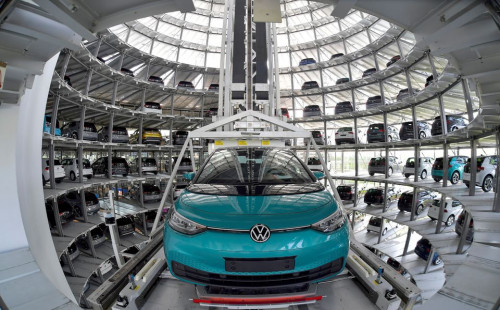Volkswagen powers up the grid to take on Tesla

Volkswagen (VOWG p.DE) is set to
double the number of employees in its charging and energy division, introduce
new payment technology next year, and take on Tesla (TSLA.O) in one More
alliances are planned. The Key Electric Vehicle (EV) Battleground: Power
Infrastructure.
Europe’s biggest
carmaker hopes to convince drivers concerned about battery range by ensuring
they have enough fast-charging plugs and enough power for electric cars that
they can give up their fossil fuel cars for good.
Outlining its electric ambition,
Volkswagen has drafted in electric industry veteran Elke Temme, who has hired
German energy companies RWE (RWEG.DE) and German energy companies RWE (RWEG.DE)
to help the carmaker get in better shape to take on Tesla. Spent almost two
decades at Innogy.
In the job since January, Temme, 53,
has been tasked with the carmaker’s various
power activities such as procuring energy, enabling customers to charge their
cars at home and on the road, and selling essential electricity.
Accomplishing this will require a
larger workforce and Temme plans to double the workforce in Volkswagen’s European
charging and energy division, known as Ally, to about 300 in 2022, with it
already this year. has tripled, he told Businesshala in an interview.
“We are
investing in huge growth areas that are not always profitable. We always look
at these investments in the overall context of our group strategy,” she said. “That’s why
building a comprehensive infrastructure is important.”
Temme declined to specify the budget
given to him, but said that Volkswagen, led by Tesla fan Herbert Diess, has
approved investment requests for the division, which also sells home battery
storage systems similar to Tesla’s Powerwall.
Is.
Volkswagen leads the pack worldwide
with its investment plans for EVs and batteries by 2030, a . According to
Businesshala analysis, and it plans to spend 35 billion euros on battery EVs by
2025.
But when it comes to the network of
fast-chargers many analysts believe are key to bringing EVs into the
mainstream, VW has some catching up to do.
Tesla has been rolling out
high-performance superchargers for years and has a global network of about
30,000 fast-chargers, which it says can accelerate to 200 km (125 miles) in 15
minutes.
The company said in October that its
own network had doubled in the past 18 months — and would
triple in the next two years.
Meanwhile, Volkswagen expects to
nearly quadruple its network of fast-chargers to 45,000 by 2025 when it aims to
overhaul Tesla as the global EV market leader pumping out 18,000 EVs in Europe,
18,000 in China. 17,000 and 10,000 in North America.
In March Volkswagen said it planned
to spend 400 million euros on expanding its fast-charging network across the
continent by then.
But that’s a drop in
the sea compared to the 5 billion euros the EU expects by 2040 to expand
charging infrastructure on the continent, and is increasing pressure on
utilities and governments.
In Europe, Volkswagen Group is a
shareholder in the EU fast-charging venture Ionity along with rival carmakers
BMW (BMWG.DE), Daimler (DAIGn.DE), Mercedes-Benz, Ford (FN) and Hyundai
(005380.KS) . ,
It has teamed up with energy firms
such as Italy’s Enel (ENEI.MI), Britain’s BP (BP.L)
and Spain’s Iberdrola (IBE.MC) to bridge geographic gaps
and how funding for EV infrastructure can be divided , its blueprint has been
prepared. across industries.
“Different
models can be envisioned, from product partnerships and joint ventures to
M&A,” Teme said.
Tesla has already shown that when it
comes to EVs, just selling the car doesn’t cut it. It
has adopted a model that offers customers everything from cars to battery
storage to solar panels Lightning In some US states.
Volkswagen is now selling power to
retail customers who drive EVs or plug-in hybrids. Teme said one of its tariffs
which is available to customers who don’t have VW has
attracted more than 10,000 customers since its launch in July.
It said VW was planning to make its
fast-charger available to all EV drivers, unlike Tesla, which has so far only
kept its supercharging network for Tesla drivers with the exception of a pilot
program in the Netherlands.
“We are
taking a different approach than Tesla when it comes to charging infrastructure
roll-out,” Teme said.
“We want an
open, non-discriminatory charging network and will evolve our services to make
our offerings more comfortable, simpler, more attractive.”
Volkswagen says its open-to-all
approach means that buyers of its EVs can charge at more than 250,000 existing
public charging points across Europe with different charging speeds from
different providers.
The problem is that charging
protocols and payment methods can vary across vendors, potentially turning the
task of refueling an EV into a time-consuming and messy undertaking.
From the first quarter of 2022,
Volkswagen plans to offer “plug and charge” technology
in Europe to simplify the process.
The car will store the owner’s payment
details and make contactless payments when the charging plugs are connected to
the EV at the refueling stations set up for the service.
While these are new challenges for
the established carmaker, Temme, who abruptly shifted Germany’s utilities
away from nuclear power in the wake of the Fukushima disaster, believes they
can be mastered.
He said, “Utilities
must reinvent themselves and transition from nuclear and coal to renewable
energy. In the automotive industry, including Volkswagen, the question
currently is how to shift the constant focus from conventional vehicles to
sustainable mobility”, He said.
“These
challenges are of equal magnitude.”
($1 = 0.8738 Euro)
.png)













